I had hoped to spend a lot of this winter doing cross-country skiing. Instead the coldest temperatures Ukraine had seen in nearly a century came with no snow. It has been snowing heavily lately, but Irina and I couldn’t make our schedules match up.
Winter is fast running out, with it coming up to 0 every afternoon, turning the streets muddy before they refreeze into a sheet of ice every night. Ironically, I wanted winter to hold out just a little longer so I could try out cross country skiing.
But that’s done now, so winter go away.
When we were finally able to go, Irina handed me a 40 year-old pair of what looked like bowling shoes. They were two sizes too big and laces of these shoes had been broken, causing the previous user to skip holes in order to lace them up, meaning they were even looser than the two-sizes would normally allow for. I felt not only awkward wearing them, but I was a little confused by the two inch hunk of leather jutting forward from each toe, making them the sort of shoes drunk clowns would wear if they went bowling (and why do you never see clowns bowling, anyway? Are they too good for it? Is it not funny enough? What’s the deal?).
The skis, which were only about 20 years old, clamped down onto the leather bits.

The shoes

The skis
Off we went, from her house. Snow had been falling steadily for almost four days, leaving about six inches of fresh powder. Fresh powder is good if you’re downhill skiing, but a trail-breaking endeavor if you’re cross-country skiing, especially if it’s your first time. I kept my skis lined up in the two tracks Irina was carving in the snow, gliding over her hard work.
It was actually a lot of fun and not nearly as difficult as I thought it would be. A couple times I got my skis crossed trying to turn, but otherwise was able to stick to the simple, albeit full-body, motion needed to keep going forward.
I once learned from an infomercial (for an exercises machine that mimicked cross-country skiing) that it’s the best aerobic workout on the planet. At the time, this felt very true. It’s especially true if you’ve been climbing on, say, Saturday and then went to a club and danced for four hours that night and then, say, got up six hours later to go climbing with Jon on Sunday, and when you climb with Jon you find that he and you turn into idiot masochists who try to do the hardest conceivable challenges in an effort to prove your manhood and then, say, because you could only squeeze in skiing that morning, wake up 6:45 AM after staying up late watching Brokeback Mountain, which made you feel like crying but you didn’t because you’re a man, and it also slightly confused you because suddenly you wondered if you had latent homosexual feelings for Jon, and so then you had to do 100 push-ups and drink three shots of vodka to prove your manhood to yourself. And then you went cross-country skiing.
It certainly felt like the best aerobic workout on the planet.
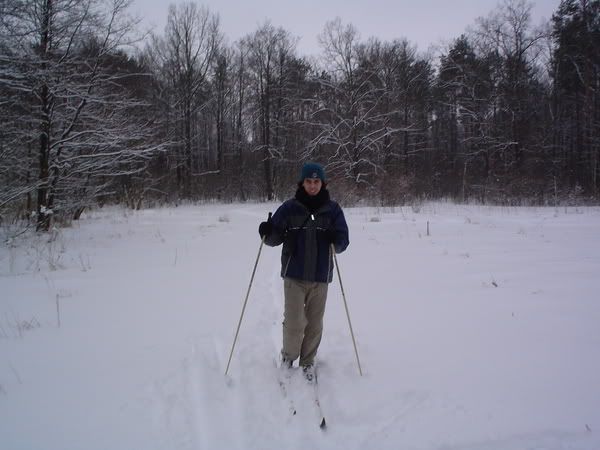
Me skiing
And that was all true for me except for the bits after Brokeback Mountain. Except, perhaps, the latent homosexual feelings bit. It’s hard to tell, them being latent and all.
Anyway.
Back to me skiing with a hot Ukrainian girl.
We skied across the interstate (I’m not kidding) and into the woods. This is all about ten miles outside of Zhytomyr, near Irina’s village, the name of which I can’t remember.
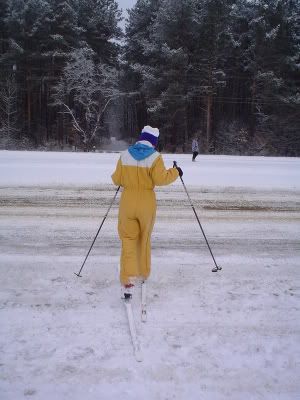
Irina skiing across the interstate
The woods were gorgeous, the naked tree limbs frosted with snow. At times, a gust of wind would come up, sending down tiny snowfalls into the quiet. We skied through the forest for a long time, then came upon several areas without trees that were fenced off with low, wooden fencing.
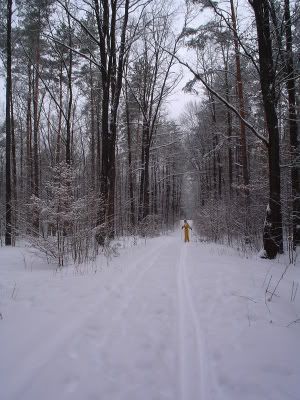
Irina skiing ahead of me
Now for the sobering part.
Irina hadn’t told me about these, hadn’t even really meant to show me, but they were beside the path. I saw at least four of these fenced off areas, but I’m told there’s many more. A granite obelisk standing in the woods about ten feet back from the path tells in Russian that these areas are mass graves which hold thousands (no actual number, just that word: thousands) of soldiers, officers and citizens who bravely died protecting the Soviet Union from the fascists.
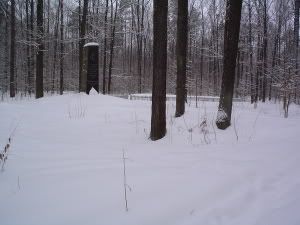
The obelisk. You can see one of the mounds to the right.
At least that’s what it says.
“They can write anything they want to write,” said Irina. She told me who was buried in those mass graves: Jews.
I’ve been told the Holocaust started here, in the Zhytomyrska Oblast. If what I’m told is true, the first set of mass Jewish executions happened in the town 30 miles south of Zhytomyr, Berdichiv. A once-thriving city with a majority Jewish population, 40,000 of the 60,000 people living in Berdichiv were shot by invading Germans and buried in mass graves outside the city.
And here is where the Jews of Zhytomyr and the surrounding area were buried. We looked at the mounds, but didn’t go near them.
“The older people, they say the ground used to breathe here,” said Irina. And of course it would: methane from the decomposing bodies would have seeped and bubbled to the surface. The mounds were later covered in sand, Irina went on, sand that was now covered by snow. When she was a child, her class would come to these graves and remove the leaves and twigs that had fallen onto the sand. This had been really unpleasant, she said, because of the bones they’d end up touching.
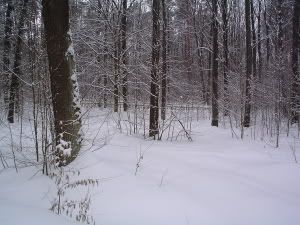
Another grave. You can see the fencing through the trees.
Bones? I knew that the Germans had realized a need to cover these killings, which is why the began the concentration camps and the crematoriums. During the war, captured Soviet soldiers had been forced to dig up most of the early mass graves and burn the bodies. The memorial to the 120,000 Jews killed at Baba Yar in Kyiv, for example, sits on earthen mounds full of ashes but empty of bones. I knew Berdichiv had been overlooked, and that under its earth still lay the bones of thousands of Jews. What I had been told, though, was that it was the only such mass grave left over from the Holocaust.
Bones, said Irina. Many Jews had swallowed jewelry to hide it from the Germans. After the war, Ukrainians had dug up the graves looking for the jewelry that that Jews had swallowed. I forgive them for it: Ukraine had just been recovering from the famine Stalin had imposed and World War I before that when the German war machine tore through Ukraine on its drive towards Moscow, leaving the country in ruins and half the male population dead. Anti-Semitism in Ukraine aside (and there’s plenty of it), I think there were motivations of survival in the desecration.
But, understandable or not, the digging had churned up bones which now no longer lay just in the earth, but in the sand Irina and her classmates had to pick clean every year.
I slowly digested all this before we started skiing again, slowly gliding off into the falling snow that floated down, covering the sand and yet still failing to cover the sins…